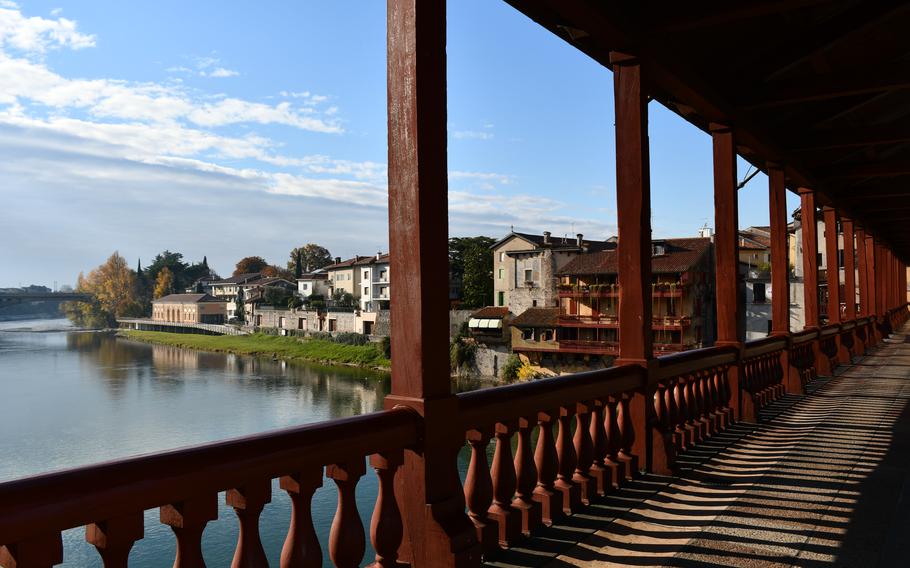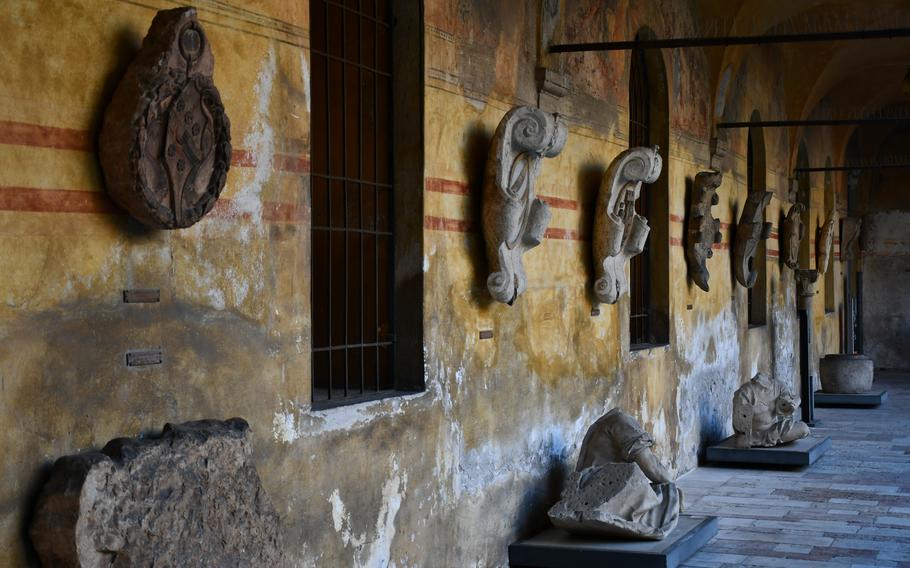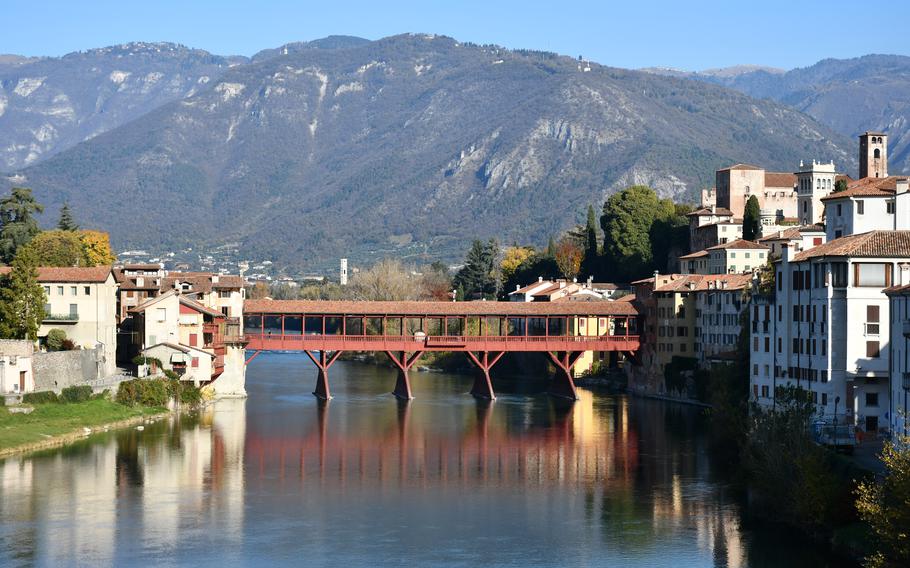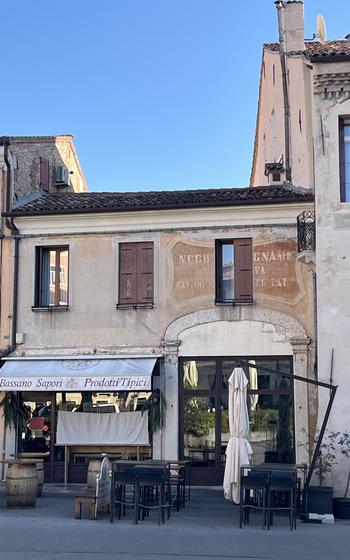
The Ponte Vecchio in Bassano del Grappa, Italy, offers views of the Italian Alps and the Brenta River. (Rebecca Holland/Stars and Stripes)
In a place with as much history as Italy, it’s common to encounter firsts, whether it’s the first bank, the oldest university or even the first espresso machine.
In Bassano del Grappa, about 20 miles from Vicenza at the base of the Monte Grappa hills, you’ll find the first grappa distillery.
Farmers had long made stronger alcohol out of grape pomace once they’d used the grape juice for wine. They would sell it door to door, but one salesman, Bortolo Nardini, planted permanent roots here in 1779.
He called it Aquavite di Vinaccia, which meant both “water of life” and “water of the vine.”
This “water of life” is what drew me to Bassano del Grappa one very hot day in July. After years of working in Italian restaurants in the U.S., I was familiar with grappa but didn’t love it.
Strong, bitter and typically consumed by older men after dinner is how I thought of it. But after learning that it was first produced so close to my new home and hearing friends rave about the town’s beauty, I decided to revisit my relationship with grappa.
At the Nardini distillery I learned about the family’s history, followed the distillation process and sampled grappa cocktails in the onsite bar. While straight grappa is still not my favorite, I did gain an appreciation for how it’s made.
Plus, Nardini makes a cocktail called mezzo e mezzo, which I loved. It’s an aperitif made with rhubarb, citrus, gentian roots and other herbs, served with a splash of soda water and lemon peel. A little bitter, a little sweet, like a slightly fruitier vermouth.

The Museo Civico in Bassano del Grappa, Italy, is one of the oldest museums in the Veneto region and houses famous sculptures and frescoes. The exterior has iterations of the city crest over the past 500 years. (Rebecca Holland/Stars and Stripes)
At the Poli museum down the street, visitors can learn about the town’s other famous grappa family and see some of the original distillation tools, as well as taste more than 20 flavors of the beverage. Here, I fell for a plum grappa, though most of my travel companions liked the citrus flavor the best.
But don’t be fooled into thinking from the name Bassano del Grappa that this town of about 70,000 people is all about imbibing. The main attraction is the gorgeous Ponte Vecchio over the Brenta River.
The wooden bridge is sometimes called Ponte degli Alpini in honor of the Italian troops who crossed the bridge on their way to defend the Sette Comuni plateau during World War I.
It was originally designed in 1567 by Andrea Palladio, who also designed Vicenza’s most famous buildings. The original lasted 200 years before it collapsed after a flood.
It was rebuilt in the same design but burned down and was rebuilt again. In 1945, an explosion destroyed the bridge yet again, but the Alpini rebuilt it to Palladio’s specifications.
During my July visit, the covered bridge was crowded with people of all ages eating gelato and hanging out in the shade. I returned in mid-November, and this time people were drinking hot wine and taking photos of the snow-capped mountains.
The views from the bridge are gorgeous, but the best vantage point of the bridge itself is the courtyard of Palazzo Sturm, which looks over the river and toward the bridge and mountains. Inside, the Rococo-style mansion hosts rotating modern art exhibits.

The Ponte Vecchio over the Brenta River in Bassano del Grappa, Italy, was first designed by Andrea Palladio but has been rebuilt three times. (Rebecca Holland/Stars and Stripes)
For the history of Bassano del Grappa, walk about five minutes from Palazzo Sturm to the Civic Museum, one of the oldest museums in the Veneto region.
My stay there was longer than expected because of the large collection of Antonio Canova sculptures and Giambattista Tiepolo paintings. You’ll want to reserve 90 minutes to two hours to take it all in.
Fans of Ernest Hemingway’s “Across the River and into the Trees” or “A Farewell to Arms” might recognize descriptions of Bassano del Grappa. He was stationed here during World War I and included the town and events he witnessed in some of his novels.
Today, the Hemingway Museum of the Great War in the Villa Ca Erizzo Luca, which was an American Red Cross station during the war, holds a collection of his letters and interviews about his time in the area.
“A Farewell to Arms” is one of my all-time favorite books, so the museum gives me a good excuse to return to Bassano del Grappa. Note that it’s closed on Mondays and sometimes for special events, which have thwarted my attempts to visit so far.

The historic center of Bassano del Grappa, Italy, has shops selling grappa, cheese and other local products. (Rebecca Holland/Stars and Stripes)
Even with all these draws, though, simply walking around Bassano del Grappa and taking in the fresh mountain air is a pleasure unto itself. The pastel-colored buildings lining the piazzas feel different and more alpine than in Vicenza even though it’s nearby, and I’m a sucker for the shop names painted directly onto the buildings — perfect for Instagram.
Bassano del Grappa is an easy day trip from Vicenza. Depending on traffic, the drive takes 30 to 45 minutes. Even with museums, distillery visits and a meal, about five or six hours is plenty of time to enjoy this town to the fullest.
With so much of Italy overrun by tourism, it’s nice to visit a place that’s unburdened by it. Restaurants have seating, there’s no line for gelato and snagging the best seat to sip grappa with a view is easy, even in the height of tourist season.
During my November visit, lights were going up and stalls were being built for the Christmas market, which runs on weekends through Jan. 6. All the more reason to return soon.